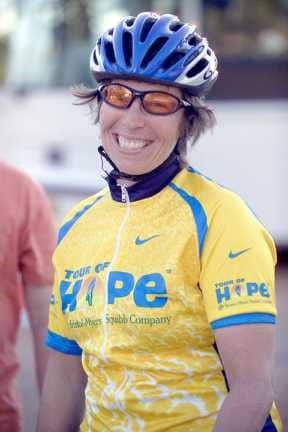Oct. 16, 2019
There are now more than 16.9 million cancer survivors in the United States, and 40 million worldwide—a figure expected to double by 2040. Improved prognosis has created a growing need to address the unique health issues facing cancer survivors that result from the disease, its treatment and related conditions.

New guidance published today from exercise oncology experts recommends the systematic use of an “exercise prescription” by health care workers and fitness professionals in designing and delivering exercise programs that aim to lower the risk of developing certain cancers and best meet the needs, preferences and abilities of people with cancer.
Anna L. Schwartz, a Northern Arizona University professor and associate director of research for the School of Nursing, has a leading role in the new guidelines. A pioneering researcher in exercise oncology whose work started the exercise oncology movement back in the early 1990s, Schwartz is also an oncology nurse practitioner and knows what a critical role nurses play in helping cancer survivors live full and meaningful lives.
Changing the paradigm
The guidance, which appears in three publications, is a result of discussions by a roundtable of experts from 17 organizations convened by the American College of Sports Medicine (ACSM)—which included the American Cancer Society and the National Cancer Institute—to review the latest scientific evidence and offer recommendations about the benefits of exercise for prevention, treatment, recovery and improved survival. Schwartz was an invited expert at the roundtable.
“Exercise provides enormous benefit for cancer survivors and is a critical component of cancer care that is underutilized and often overlooked,” Schwartz said. “Exercise not only helps to reduce risks for many cancers, but it also helps to improve survival and reduces many of the side effects of treatment. Our goal is to change the paradigm so that all cancer survivors are referred to an appropriate exercise program to improve their health and ability to live life to the fullest.”
The new evidence-based guidance includes the following recommendations:
- For all adults, exercise is important for cancer prevention and specifically lowers risk of seven common types of cancer: colon, breast, endometrial, kidney, bladder, esophagus and stomach.
- For cancer survivors, incorporate exercise to help improve survival after a diagnosis of breast, colon or prostate cancer.
- Exercising during and after cancer treatment improves fatigue, anxiety, depression, physical function and quality of life and does not exacerbate lymphedema.
- Continue research that will drive the integration of exercise into the standard of care for cancer.
- Translate into practice the increasingly robust evidence base about the positive effects of exercise for cancer patients.
The comprehensive review and recommendations are outlined in several academic papers published today in scientific journals, two of them co-authored by Schwartz. “Exercise Guidelines for Cancer Survivors: Consensus Statement from International Multidisciplinary Roundtable” was published in Medicine & Science in Sports & Exercise, ACSM’s flagship research journal. “Exercise Is Medicine in Oncology: Engaging Clinicians to Help Patients Move Through Cancer,” appeared in CA: A Cancer Journal for Clinicians, a flagship journal of the American Cancer Society.
“We have a growing need to address the unique health issues facing people living with and beyond cancer and better understand how exercise may help prevent and control cancer,” said ACSM Immediate Past President Katie Schmitz, who co-chaired the roundtable.
“This esteemed, multidisciplinary group of leaders on the forefront of exercise oncology aimed to translate the latest scientific evidence into practical recommendations for clinicians and the public and to create global impact through a unified voice.”
To implement the recommendation for translating evidence into practice, ACSM also introduced a new program, Moving Through Cancer, implemented by a task force of six experts that includes Schwartz.
“The goal of the Moving Through Cancer initiative is to make exercise assessment, advice, referral and engagement standard practice for all people living with and beyond cancer by 2029,” Schwartz said. “This includes workforce development (training current professionals and changing education, undergrad through grad), changing practice, infrastructure, programming policy, funding and sustainability.”
The clinician-focused program aims to ensure that all people living with and beyond cancer are assessed, advised, referred to and engaged in appropriate exercise and rehabilitation programming as a standard of care. Resources are available for oncology clinicians and patients, including a global, searchable registry of exercise programs.

Kerry Bennett
Office of the Vice President for Research


